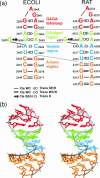Molecular dynamics simulations of sarcin-ricin rRNA motif
- PMID: 16456030
- PMCID: PMC1360246
- DOI: 10.1093/nar/gkj470
Molecular dynamics simulations of sarcin-ricin rRNA motif
Abstract
Explicit solvent molecular dynamics (MD) simulations were carried out for sarcin-ricin domain (SRD) motifs from 23S (Escherichia coli) and 28S (rat) rRNAs. The SRD motif consists of GAGA tetraloop, G-bulged cross-strand A-stack, flexible region and duplex part. Detailed analysis of the overall dynamics, base pairing, hydration, cation binding and other SRD features is presented. The SRD is surprisingly static in multiple 25 ns long simulations and lacks any non-local motions, with root mean square deviation (r.m.s.d.) values between averaged MD and high-resolution X-ray structures of 1-1.4 A. Modest dynamics is observed in the tetraloop, namely, rotation of adenine in its apex and subtle reversible shift of the tetraloop with respect to the adjacent base pair. The deformed flexible region in low-resolution rat X-ray structure is repaired by simulations. The simulations reveal few backbone flips, which do not affect positions of bases and do not indicate a force field imbalance. Non-Watson-Crick base pairs are rigid and mediated by long-residency water molecules while there are several modest cation-binding sites around SRD. In summary, SRD is an unusually stiff rRNA building block. Its intrinsic structural and dynamical signatures seen in simulations are strikingly distinct from other rRNA motifs such as Loop E and Kink-turns.
Figures







Similar articles
-
The two faces of the Escherichia coli 23 S rRNA sarcin/ricin domain: the structure at 1.11 A resolution.J Mol Biol. 1999 Sep 17;292(2):275-87. doi: 10.1006/jmbi.1999.3072. J Mol Biol. 1999. PMID: 10493875
-
The phenotype of mutations of the base-pair C2658.G2663 that closes the tetraloop in the sarcin/ricin domain of Escherichia coli 23 S ribosomal RNA.J Mol Biol. 2000 May 19;298(5):795-805. doi: 10.1006/jmbi.2000.3720. J Mol Biol. 2000. PMID: 10801349
-
Characterization of in vitro and in vivo mutations in non-conserved nucleotides in the ribosomal RNA recognition domain for the ribotoxins ricin and sarcin and the translation elongation factors.J Mol Biol. 1999 Jan 15;285(2):567-80. doi: 10.1006/jmbi.1998.2337. J Mol Biol. 1999. PMID: 9878430
-
RNA recognition and base flipping by the toxin sarcin.J Synchrotron Radiat. 2004 Jan 1;11(Pt 1):93-6. doi: 10.1107/s0909049503023896. Epub 2003 Nov 28. J Synchrotron Radiat. 2004. PMID: 14646144 Review.
-
Ribotoxin recognition of ribosomal RNA and a proposal for the mechanism of translocation.Trends Biochem Sci. 1992 Jul;17(7):266-9. doi: 10.1016/0968-0004(92)90407-z. Trends Biochem Sci. 1992. PMID: 1502728 Review.
Cited by
-
Elastic network models for RNA: a comparative assessment with molecular dynamics and SHAPE experiments.Nucleic Acids Res. 2015 Sep 3;43(15):7260-9. doi: 10.1093/nar/gkv708. Epub 2015 Jul 17. Nucleic Acids Res. 2015. PMID: 26187990 Free PMC article.
-
Elastic properties of ribosomal RNA building blocks: molecular dynamics of the GTPase-associated center rRNA.Nucleic Acids Res. 2007;35(12):4007-17. doi: 10.1093/nar/gkm245. Epub 2007 Jun 6. Nucleic Acids Res. 2007. PMID: 17553840 Free PMC article.
-
Platinum-RNA modifications following drug treatment in S. cerevisiae identified by click chemistry and enzymatic mapping.ACS Chem Biol. 2014 Oct 17;9(10):2404-11. doi: 10.1021/cb500395z. Epub 2014 Aug 15. ACS Chem Biol. 2014. PMID: 25055168 Free PMC article.
-
Mayahuelin, a Type I Ribosome Inactivating Protein: Characterization, Evolution, and Utilization in Phylogenetic Analyses of Agave.Front Plant Sci. 2020 May 27;11:573. doi: 10.3389/fpls.2020.00573. eCollection 2020. Front Plant Sci. 2020. PMID: 32528490 Free PMC article.
-
Molecular dynamics simulations of human tRNA Lys,3 UUU: the role of modified bases in mRNA recognition.Nucleic Acids Res. 2006;34(19):5361-8. doi: 10.1093/nar/gkl580. Epub 2006 Sep 29. Nucleic Acids Res. 2006. PMID: 17012271 Free PMC article.
References
-
- Hausner T.P., Atmadja J., Nierhaus K.H. Evidence that the G2661 region of 23S ribosomal-RNA is located at the ribosomal-binding sites of both elongation-factors. Biochimie. 1987;69:911–923. - PubMed
-
- Moazed D., Robertson J.M., Noller H.F. Interaction of elongation-factors Ef-G and Ef-Tu with a conserved loop in 23S RNA. Nature. 1988;334:362–364. - PubMed
-
- Endo Y., Wool I.G. The site of action of alpha-sarcin on eukaryotic ribosomes—the sequence at the alpha-sarcin cleavage site in 28 S-ribosomal ribonucleic-acid. J. Biol. Chem. 1982;257:9054–9060. - PubMed
-
- Endo Y., Mitsui K., Motizuki M., Tsurugi K. The mechanism of action of ricin and related toxic lectins on eukaryotic ribosomes—the site and the characteristics of the modification in 28-S ribosomal-RNA caused by the toxins. J. Biol. Chem. 1987;262:5908–5912. - PubMed
Publication types
MeSH terms
Substances
LinkOut - more resources
Full Text Sources
Miscellaneous

